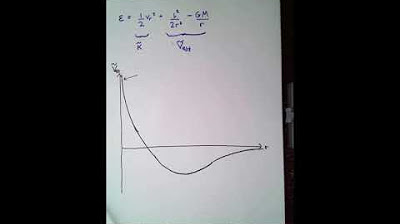The most beautiful idea in physics - Noether's Theorem
Summary
TLDRThis script delves into Emmy Noether's groundbreaking theorem, illustrating how symmetries in a system correspond to conservation laws in physics. It explains the concept of symmetry beyond mere aesthetic appeal, extending to transformations that leave a system's energy unchanged. The video uses examples like translational and rotational symmetry to demonstrate how these symmetries imply conservation of momentum and angular momentum, respectively. It also touches on the profound implications of Noether's theorem for understanding the natural laws governing our universe, including its application in quantum mechanics.
Takeaways
- 🌌 **Symmetry in Physics**: The concept of symmetry is not just about mirror images but also includes transformations like rotation and translation that leave the system unchanged.
- 🔄 **Generalized Symmetry**: Mathematicians have generalized the concept of symmetry to include any transformation that doesn't visibly alter an object or system.
- 📚 **Importance in Mathematics**: The study of symmetry has been a driving force behind the development of abstract algebra, a significant field in modern mathematics.
- 👩🔬 **Emmy Noether's Theorem**: Emmy Noether's work on symmetry led to a profound theorem in physics that links symmetries to conservation laws.
- 🌀 **Symmetry Examples**: Examples of symmetries include a particle being translationally symmetric if its energy remains the same when shifted, or a rotating object being rotationally symmetric if its gravitational potential energy remains constant.
- 💡 **Conservation Laws**: Conservation laws are fundamental in physics, stating that certain quantities like momentum and energy remain constant over time if no external forces act on the system.
- 🌟 **Noether's Theorem Explained**: Noether's theorem explains the origin of conservation laws by stating that if a system is symmetric under a certain transformation, then a corresponding quantity is conserved.
- 🌍 **Universal Symmetry**: The theorem can be applied universally, from a single particle to the entire universe, to determine if certain symmetries imply conservation of specific quantities.
- 🔍 **Practical Use of Theorem**: Noether's theorem provides a method to determine what is conserved in a system by checking for symmetries, which is invaluable in solving complex physics problems.
- 🔮 **Quantum Mechanics Connection**: The concept of time translation symmetry and its relation to energy conservation is particularly important in the realm of quantum mechanics.
- 🎓 **Further Exploration**: The video encourages viewers to explore the idea of Noether's theorem further, consider its applications in different contexts, and even attempt to prove it with a background in calculus and classical physics.
Q & A
What does the thought experiment about shifting everything in the universe to the right imply?
-The thought experiment suggests that if the universe could be shifted and no difference is observed, it implies a certain symmetry in the system, which according to Noether's theorem, would lead to a conservation law.
What is the significance of Emmy Noether's discovery in physics?
-Emmy Noether discovered the profound idea that symmetries in a system imply conservation laws, which is a cornerstone concept in theoretical physics, linking abstract mathematical symmetries to observable physical phenomena.
How is the concept of symmetry generalized in mathematics?
-In mathematics, symmetry is generalized to mean that an object remains indistinguishable under a certain transformation, such as rotation, translation, or scaling, which can be applied to a vast range of mathematical objects and structures.
What is the connection between symmetry and conservation laws as described in the script?
-The connection is established through Noether's theorem, which states that for every continuous symmetry in a system, there is a corresponding conservation law. This means that the invariance of a system under certain transformations leads to the conservation of a quantity like energy, momentum, or angular momentum.
Why are conservation laws important in physics?
-Conservation laws are fundamental in physics because they provide a way to predict the behavior of systems over time without the need for detailed knowledge of the system's dynamics. They simplify complex problems and are essential in both classical and quantum mechanics.
What is an example of translational symmetry given in the script?
-An example of translational symmetry is a particle in isolation, where shifting its position does not change its energy, implying that the system's momentum is conserved.
How does rotational symmetry relate to the conservation of angular momentum?
-According to Noether's theorem, if a system has rotational symmetry around a certain axis, then the angular momentum around that axis is conserved, as the total energy of the system remains unchanged under rotation.
What does time translation symmetry imply in the context of Noether's theorem?
-Time translation symmetry implies that the energy of a system is conserved. This means if a system's energy remains the same over time, it exhibits time translation symmetry.
How does the script differentiate between systems where momentum is conserved and those where it is not?
-The script differentiates by examining whether the system has translational symmetry. If a system's energy changes when it is translated (e.g., due to gravitational potential energy differences), it lacks translational symmetry, and momentum is not conserved.
What is the significance of the 'homework' section at the end of the script?
-The 'homework' section encourages further exploration of Noether's theorem and its implications. It prompts viewers to consider the concept's applications, explore related topics like supersymmetry, and possibly attempt to prove the theorem or identify new systems with unique symmetries.
Outlines

This section is available to paid users only. Please upgrade to access this part.
Upgrade NowMindmap

This section is available to paid users only. Please upgrade to access this part.
Upgrade NowKeywords

This section is available to paid users only. Please upgrade to access this part.
Upgrade NowHighlights

This section is available to paid users only. Please upgrade to access this part.
Upgrade NowTranscripts

This section is available to paid users only. Please upgrade to access this part.
Upgrade NowBrowse More Related Video
5.0 / 5 (0 votes)





